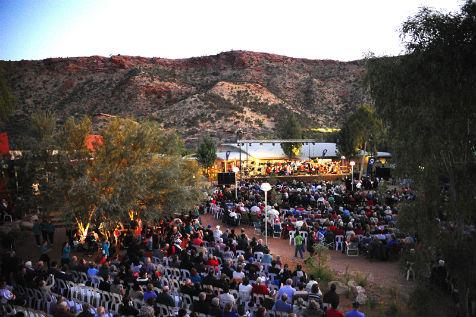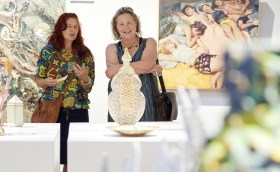Get help writing and don’t worry too much about slick. After 10 years of judging Creative Partnerships Australia/AbaF awards, a judge reveals how he decides.
Judging any arts awards can be tricky. Sometimes art is a matter of taste, and judges have to be really alert to that. At the arts-business nexus it is sometimes hard not to be attracted by the sheer novelty and verve of the things that people are doing, but novelty can be a distraction. And familiarity can lead judges into making safe, comfortable decisions. So the judges have to be alive to all these issues, suspend their personal likes and dislikes and dig really deeply into the substance of what’s happening.
The business side is another whole dimension in the judging. The criteria are not about artistic merit so much as about the partnership or program. Just have a look at the criteria for the Visy Environmental Sustainability Award. The things that matter are about strategic fit between the activity and the organisation’s aims or goals, and the evaluation tools used and so on. One past winner was a theatre company. The things that made them the winner were not so much the artistry in the sets that were built and used sustainably, but the fit between their set design and use, and their artistic strategy.
The nomination process gets artists and arts companies and their business counterparts thinking differently about what they are doing. And that can only be good for everyone. One of my strong messages is that the award nomination process is a real opportunity for people to think rigorously about their activities. Because the word limits are so tough, you have to think well, and that can flow through to how the business and artists see what they are doing.
Most artists and businesses are used to expressing themselves in a particular way and often that is not in writing. Award nominations are in a class of their own, and the writing is a bit different. Nominations are a special, clipped form of non-fiction writing – much harder than most people think. A nice analogue might be the public service job application!
Those wonderfully creative people in music, theatre, dance, visual arts are not necessarily great at telling a story in written words. Sometimes their business counterparts have the same issues but for different reasons. So many nominations don’t do justice to the nominees because the words have got in the way. A free tip to nominees: have a critical friend or two go over the written part of the nomination.
The words are all the judges have really, and they are the main way you tell your story. If they are put together badly it gets hard to assess the claim. I’m not just talking pet peeves about grammar (although it is easy to be distracted by stuff like split infinitives and archaic conjunctives, like ‘whilst’).
My point is that poor grammar can interfere with the message. It is easier to write clearly when you write grammatically. That said, some of the most lucid prose ever written twists, even distorts, grammar.
Writing good nominations is more that nice grammar. It has to be concise, clear and written with the judges in mind – ‘reader-focussed writing’ among the plain English crowd – and nominees know exactly who the readers are: they are the judging panels.
So find those critical friends and have them read it, reshape the words to improve the quality of the story telling. You don’t have to pay a professional editor or marketer, but some of the best written nominations I’ve read have come from marketing departments of businesses and arts companies in the word-based arts.
Sometimes the non-word components like photographs, video or sound are really important, the best way for judges to understand what is being done, especially artistically, or get a sense of the community aspects of some awards. Slick can help, but not that much. The judges I know are all pretty good at seeing through production value into the substance. The “wow” factor will rarely shift the way a judge thinks.
I think strategic use of the background information is a good investment too. It is never scored, but it can give a terrific insight for the judge into the what, why and how of the nomination. Think of it as a free kick you can’t score from, but gets you closer to the goal line.
I have my own preferred way. I guess all judges do, and I can’t speak for anyone else. I deliberately take a four-stage approach. I start out by reading through all the applications. I don’t score at this stage, but I do sort them into three bundles: the really good ones; ones that seem to need a lot more work to make the grade; and the ones I can’t decide about. At this stage I’m trying really hard to see every nomination in the best light – hoping every one will be the winner. The question is ‘Can this one possibly get up?’
The second stage is my individual scoring. All those hard-won words get reduced to a single number. Scores are given against each criterion, weighted and added up. At this stage I am being really critical, looking for faults and flaws, but still trying to see each nomination on its own merits. The question is more ‘Is this worthy of winning?’ rather than ‘Is this the best of the bunch?’
That question is the third stage, when I moderate my own scores, trying to get some internal consistency, and to smooth out the bumps. Often I will start out the second phase being tougher than when I finish. Sometimes I get distracted mid-scoring. This is the stage to sort that out, and weigh each nomination up against the others in the category. The scores are popped into a computer and automatically weighted and zipped into a database in Melbourne, along with all the other judges’ scores.
The fourth stage is the one that really counts. It is the panel stage, where all the judges on the panel link up (usually by telephone) facilitated by someone from the Creative Partnerships head office. It is usually some weeks after the individual scores are input. The judges get to see all the other judges’ scores at this stage, too. The staff member’s job is to facilitate the panel discussion, tend to administration, provide guidance when needed, and maybe make a few notes for giving feedback to nominees. They are not judges and don’t give scores, but sometimes they might have a helpful reality check.
The panel discusses divergent scores, and decides category winners and best practice awards, usually by a combination of arithmetic and consensus. Questions are like these: ‘Why did we score this nomination so differently?’, ‘What was good or poor about it?’, ‘Did I miss something?’ and ‘Did my preference colour my scoring?’. Ultimately of course the questions are ‘Which one is the winner?’ and ‘Who shows best practice?’. The result is decided through collective wisdom.
In almost 10 years of judging these awards, I have never once thought an outcome was ‘bad’ or ‘undeserved’, even when my highest scoring nomination was not the eventual winner. For me, that shows that the judging process is well designed and well run.
The 2013 Creative Partnerships Australia Awards are now open. For more information, Award categories, criteria and eligibility visit creativepartnershipsaustralia.org.au.





